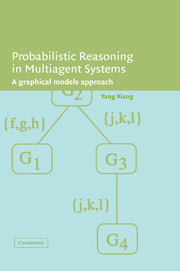Book contents
- Frontmatter
- Contents
- Preface
- 1 Introduction
- 2 Bayesian Networks
- 3 Belief Updating and Cluster Graphs
- 4 Junction Tree Representation
- 5 Belief Updating with Junction Trees
- 6 Multiply Sectioned Bayesian Networks
- 7 Linked Junction Forests
- 8 Distributed Multiagent Inference
- 9 Model Construction and Verification
- 10 Looking into the Future
- Bibliography
- Index
6 - Multiply Sectioned Bayesian Networks
Published online by Cambridge University Press: 31 August 2009
- Frontmatter
- Contents
- Preface
- 1 Introduction
- 2 Bayesian Networks
- 3 Belief Updating and Cluster Graphs
- 4 Junction Tree Representation
- 5 Belief Updating with Junction Trees
- 6 Multiply Sectioned Bayesian Networks
- 7 Linked Junction Forests
- 8 Distributed Multiagent Inference
- 9 Model Construction and Verification
- 10 Looking into the Future
- Bibliography
- Index
Summary
Chapters 2 through 5 studied exact probabilistic reasoning using a junction tree representation converted from a Bayesian network. The single-agent paradigm is followed in the study. Under this paradigm, a single computational entity, an agent, has access to a BN over a problem domain, converts the BN into a JT, acquires observations from the domain, reasons about the state of the domain by concise message passing over the JT, and takes actions accordingly. Such a paradigm has its limitations: A problem domain may be too complex, and thus building a single agent capable of being in charge of the reasoning task for the entire domain becomes too difficult. Examples of complex domains include designing intricate machines such as an aircraft and monitoring and troubleshooting complicated mechanisms such as chemical processes. The problem domain may spread over a large geographical area, and thus transmitting observations from many regions to a central location for processing is undesirable owing to communications cost, delay, and unreliability.
This and subsequent chapters consider the uncertain reasoning task under the multiagent paradigm in which a set of cooperating computational agents takes charge of the reasoning task of a large and complex uncertain problem domain. This chapter deals with the knowledge representation. A set of five basic assumptions is introduced to describe some ideal knowledge representation formalisms for multiagent uncertain reasoning. These assumptions are shown to give rise to a particular knowledge representation formalism termed multiply sectioned Bayesian networks (MSBNs).
- Type
- Chapter
- Information
- Probabilistic Reasoning in Multiagent SystemsA Graphical Models Approach, pp. 107 - 141Publisher: Cambridge University PressPrint publication year: 2002



